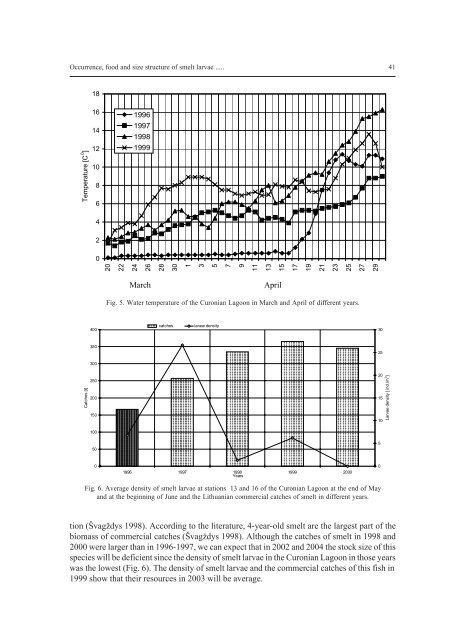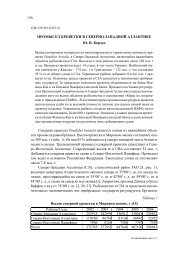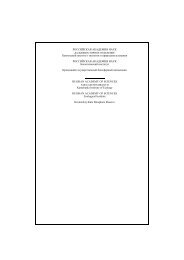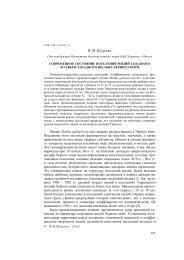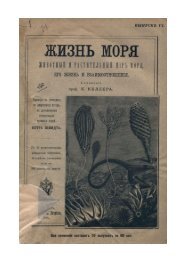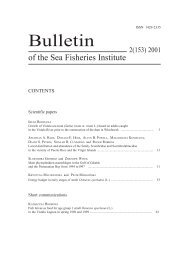Occurrence, food and size structure <strong>of</strong> smelt larvae ..... 41 18 Temperature [C 0 ] 16 14 12 10 8 6 1996 1997 1998 1999 4 2 0 20 22 24 26 28 30 1 3 5 7 9 11 13 15 17 19 21 23 25 27 29 March April Fig. 5. Water temperature <strong>of</strong> <strong>the</strong> Curonian Lagoon in March and April <strong>of</strong> different years. 400 catches larvae density 30 350 25 300 Catches [t] 250 200 150 20 15 10 Larvae density [ ind./m 3 ] 100 50 5 0 1996 1997 1998 1999 2000 Years 0 Fig. 6. Average density <strong>of</strong> smelt larvae at stations 13 and 16 <strong>of</strong> <strong>the</strong> Curonian Lagoon at <strong>the</strong> end <strong>of</strong> May and at <strong>the</strong> beginning <strong>of</strong> June and <strong>the</strong> Lithuanian commercial catches <strong>of</strong> smelt in different years. tion (Švagždys 1998). According to <strong>the</strong> literature, 4-year-old smelt are <strong>the</strong> largest part <strong>of</strong> <strong>the</strong> biomass <strong>of</strong> commercial catches (Švagždys 1998). Although <strong>the</strong> catches <strong>of</strong> smelt in 1998 and 2000 were larger than in 1996-1997, we can expect that in <strong>2002</strong> and 2004 <strong>the</strong> stock size <strong>of</strong> this species will be deficient since <strong>the</strong> density <strong>of</strong> smelt larvae in <strong>the</strong> Curonian Lagoon in those years was <strong>the</strong> lowest (Fig. 6). The density <strong>of</strong> smelt larvae and <strong>the</strong> commercial catches <strong>of</strong> this fish in 1999 show that <strong>the</strong>ir resources in 2003 will be average.
42 VIDA ŽILIUKIENE REFERENCES Anner, G., M. Blomqvist, H. Hallbäck, J. Mattila, S. Nellbring, K. Skóra and L. Urho. 1992. Methods for sampling and obsevation <strong>of</strong> shallow water fish. The Baltic marine biologists publication No. 13. Anon. 1974. Methodical manual on <strong>the</strong> research <strong>of</strong> fish nutrition and <strong>the</strong>ir nutritional relationships in natural conditions. Moscow [in Russian]. Balushkina, E.V. and G.G. Winberg 1979. Relation between plankton animals body length and weight. General principles <strong>of</strong> aquatic ecosystems research. G. G. Winberg, Leningrad: 169-172 [in Russian]. Benecke, B. 1881. Fische, Fischerei und Fischucht in Ost – und Westpreussen. Havtungche Verlagsdruckerei, Königsberg. Brooks, J. L. 1968. The effects <strong>of</strong> prey selection by lake planktivores. Syst. Zool. 17 (3): 273-291. Dussart, B. 1967. Les Copepodes des eaux continentals d’Europe occidentale. 1. Calanoides et Harpacticoides. Ed. N. Boubee Cie, Paris. Dussart, B. 1969. Les Copepodes des eaux continentals d’Europe occidentale. 2. Cyclopoides et biologie. Ed. N. Boubee Cie, Paris. Gaigalas, K., A. Gerulaitis, R. Krotas, and J. Maniukas. 1978. Fish species and fishery Nemunas. Vilnius, 2: 91-150 [in Lithuanian]. Gaigalas, K. 2001. Fish in <strong>the</strong> Curonian Bay basin, <strong>the</strong>ir resources and fishery. Egle, Klaipeda. [in Lithuanian]. Gerulaitis, A., K. Gaigalas, R. Repeèka, V. Valušiene, G. Rudzianskiene, T. Overkaite and D. Skripkaite 1996. The investigations <strong>of</strong> fish stocks and catch prognoses in <strong>the</strong> Kursiu lagoon and Nemunas delta. Fishery in Lithuania. Vilnius, II: 165-182 [in Lithuanian]. Griniene, E. 1999. The influence <strong>of</strong> macrophytes on <strong>the</strong> spatial distribution <strong>of</strong> zooplankton in <strong>the</strong> littoral zone <strong>of</strong> <strong>the</strong> Curonian Lagoon. Animal ecology. Petro <strong>of</strong>setas, Vilnius: 4-5 [in Lithuanian]. Hildén, M. and L. Urho. 1988. Sampling <strong>of</strong> larval European smelt: a factorial experiment. Am. Fish. Soc. Symp. 5: 123-145. Kiselev, L.V. 1969. Plankton in <strong>the</strong> sea and inland waters. Nauka, Leningrad [in Russian]. Kunskas, R. 1978. Physico-geographical description <strong>of</strong> <strong>the</strong> Curonian Lagoon. Curonian Lagoon. Part. 1. Mokslas, Vilnius: 11-50 [in Lithuanian]. Kutikova, L.A. 1970. Rotatoria <strong>of</strong> USSR fauna. Nauka, Leningrad: 744 [in Russian]. Lange, N.O. and E.N. Dmitrieva. 1981. Methods <strong>of</strong> ecologicalmorphological research <strong>of</strong> <strong>the</strong> development <strong>of</strong> young fish. The studies <strong>of</strong> reproduction and development <strong>of</strong> fish. Nauka, Moscow: 67-88 [in Russian]. Maniukas, J. 1959. Ichthy<strong>of</strong>auna, state <strong>of</strong> fish resources and fishery in <strong>the</strong> Curonian Lagoon. Pergale, Vilnius: 293-403 [in Lithuanian]. Manuilova, E. F. 1964. Cladocera <strong>of</strong> USSR fauna. Nauka, Moskow: 327 [in Russian]. Margonski, P. 2000. Impact <strong>of</strong> hydrological and meteorological conditions on <strong>the</strong> spatial distribution <strong>of</strong> larval and juvenile smelt (Osmerus eperlanus) in <strong>the</strong> Vistula Lagoon (sou<strong>the</strong>rn Baltic <strong>Sea</strong>). Bull. <strong>Sea</strong> Fish. Inst., Gdynia, 3 (151): 119-133. Noskova, E.D. 1972. Causes determining <strong>the</strong> dynamics <strong>of</strong> abundance <strong>of</strong> smelt in <strong>the</strong> Curonian Lagoon. Works <strong>of</strong> <strong>the</strong> International Research <strong>Institute</strong> <strong>of</strong> Fish Industry and Oceanography. 83: 286-300 [in Russian]. O’Brien, W.J., N.A. Slade and G. D. Vinyard 1976. Apparent size as <strong>the</strong> determinant <strong>of</strong> prey selection by bluegill sunfish (Lepomis macrochirus). Ecology. 57 (6): 1304-1310. Pavlov, D.S., V.N. Mikheev., M.V. Vasilev and L.Z. Pekhlivanov 1988. Nutrition, distribution and migration <strong>of</strong> fish from <strong>the</strong> water reservoir “Aleksandr Stambolijski”. Nauka, Moscow [in Russian]. Repeèka, R. 1995. Investigations <strong>of</strong> <strong>the</strong> fish fauna in <strong>the</strong> Lithuanian part <strong>of</strong> <strong>the</strong> Curonian Lagoon. Coastal Conservation and Management in <strong>the</strong> Baltic Region. Petro-<strong>of</strong>setas, Vilnius: 117-123. Repeèka, R. 1996. Assessment and monitoring <strong>of</strong> coastal fish resources. Lithuania. Assessment and monitoring <strong>of</strong> coastal fish resources in Estonia, Latvia, and Lithuania. Sweedmark Consultancy Report: 1-23.


